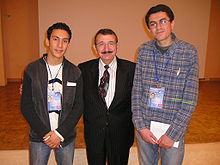Mostafa El-Sayed
Mostafa El-Sayed , also Mustapha El-Sayyed, (born May 8, 1933 in Zifta , Egypt ) is an Egyptian-American chemist, known for his contributions to nanotechnology , molecular spectroscopy and laser spectroscopy.
El-Sayed studied at the Ain Shams University in Cairo (Bachelor 1953) and was at the Florida State University with Michael Kasha with the topic Studies on some molecular and nuclear problems Part I: The C = N stretching frequency and molecular structure Part II: Mechanism for the chemical effects of nuclear transformations doctorate . He was then a post-doctoral student at Yale University (1958/59), Harvard University (1959/60) and Caltech (1960/61) before becoming a faculty member and professor at the University of California, Los Angeles ( UCLA), in the Faculty of Chemistry and Biochemistry. He has been Julius Brown since 1994 and Regents Professor at the Georgia Institute of Technology since 2000 and Director of the Laser Dynamics Laboratory there. In 1968 he was visiting professor at the American University in Beirut and in 1976 and 1991 at the University of Paris.
El-Sayed investigated a wide variety of systems from molecules, photosynthesis systems, solids to metallic nanostructures and semiconductor quantum dots with methods of laser spectroscopy, whereby his working groups used time resolutions down to the femtosecond range and also developed new methods (such as Phosphorescence Microwave Multi Resonance Spectroscopy) . In addition to chemical (nanocatalysis), solid-state physical (such as surface plasmon generation) and optical (nanophotonics) applications, he and his colleagues also investigate applications in medicine ( nanomedicine , cancer diagnosis and photothermal therapy with gold nanoparticles). He also works with his son Ivan El-Sayed, who is a professor of cancer surgery in California.
El-Sayed has authored and co-authored over 500 scientific articles and supervised over 70 doctoral students.
The El-Sayed rule in molecular spectroscopy (in the case of radiationless transitions from singlet to triplet spin states which, according to El-Sayed, have a higher probability if the molecular orbitals are different in the new state) is named after him; he introduced it in the late 1960s on.
From 1965 to 1971 he was a Sloan Research Fellow and 1967/68 Guggenheim Fellow. In 1990 he received the König Faisal Prize in Chemistry. He is a member of the American Association for the Advancement of Science (1986), the Third World Academy of Sciences (1984) and the National Academy of Sciences (1980). In 1993 he received an honorary doctorate from Hebrew University . In 2009 he received the Glenn T. Seaborg Medal and the Ahmed Zewail Prize, in 1967 the Fresenius Prize and in 2002 the Langmuir Prize . In 2007 he received the National Medal of Science . In 1982 he was Alexander von Humboldt Senior Fellow at the Technical University of Munich . He is a Fellow of the American Physical Society (2000). For 2016 he was awarded the Priestley Medal .
From 1980 he was editor of the Journal of Chemical Physics .
He has been married to Janis Jones since 1957, with whom he has three sons and two daughters.
Web links
Individual evidence
- ↑ Biographies, publications and academic family tree of Mostafa A. El-Sayed at academictree.org, accessed on January 31, 2018.
| personal data | |
|---|---|
| SURNAME | El-Sayed, Mostafa |
| ALTERNATIVE NAMES | El-Sayyed, Mustapha |
| BRIEF DESCRIPTION | Egyptian-American chemist |
| DATE OF BIRTH | May 8, 1933 |
| PLACE OF BIRTH | Zifta |
